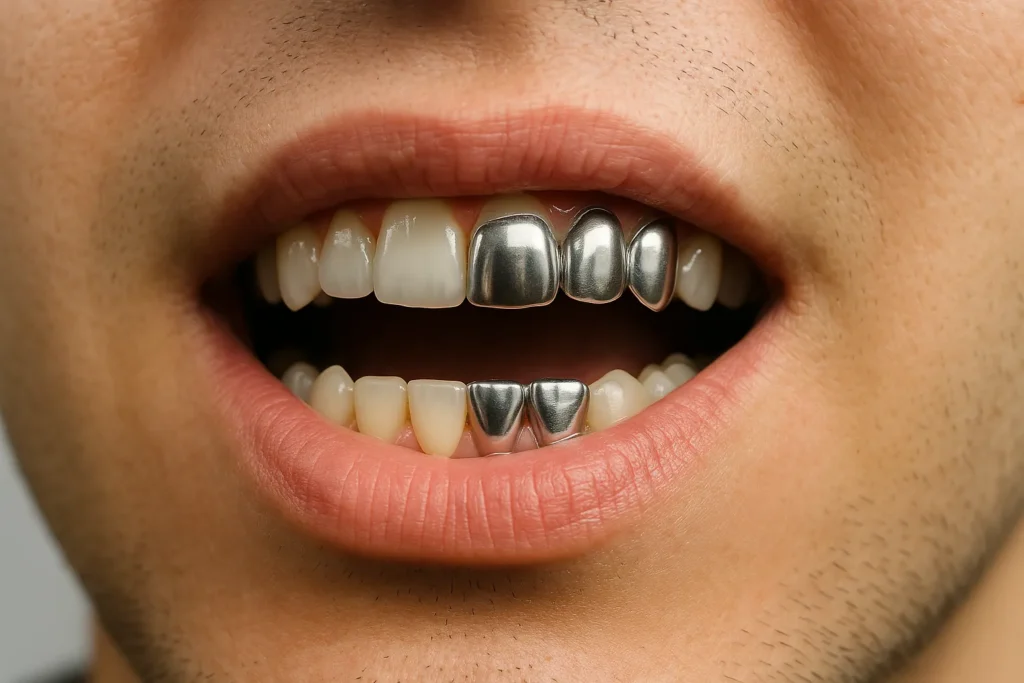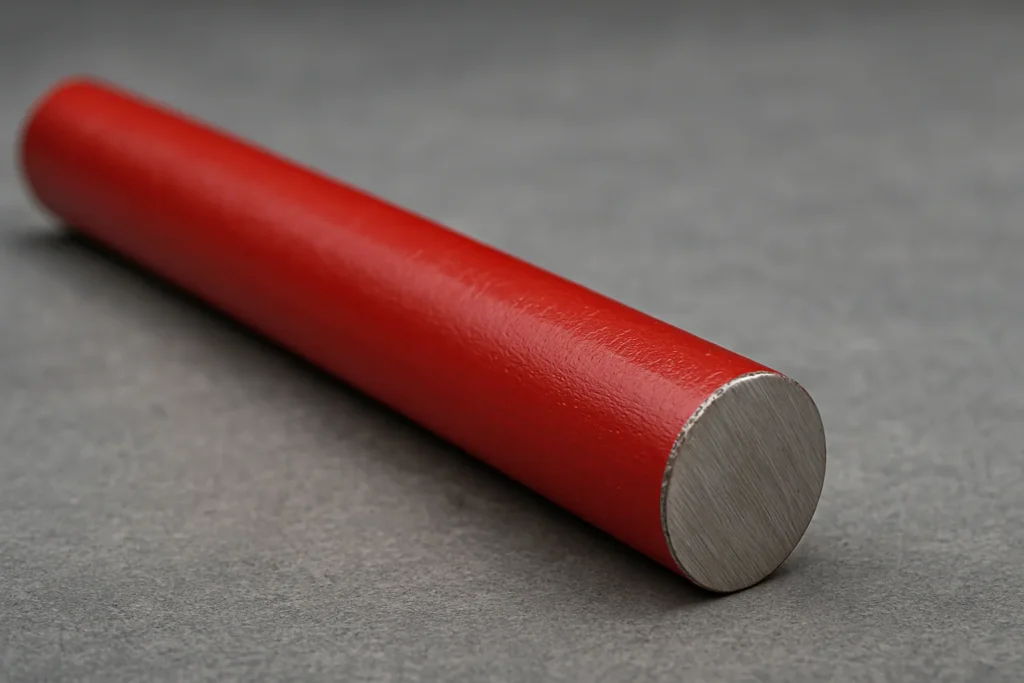When people hear the term metal teeth, they often picture shiny silver smiles or celebrities showing off gold grillz. In reality, the phrase covers many kinds of dental work. Metal crowns and caps are used to protect weak or damaged teeth. Braces and spacers guide teeth into the right position. Retainers keep them in place after orthodontic treatment. Some dentures use metal clasps or even full metal frameworks. And yes, there are also metal false teeth and decorative options worn for fashion.
So, why do people still choose metal in a world filled with ceramic and clear alternatives? The answer is simple: strength, affordability, and reliability. Metal restorations can last decades, often outlasting tooth-colored options. They are also more budget-friendly, making them accessible for many families. On top of that, some people embrace the style of metal teeth, whether it’s a practical crown in the back of the mouth or a bold front-tooth statement. And from a health perspective, metal remains a trusted material because it can handle chewing forces and protect natural teeth underneath.
In this guide, I’ll walk you through everything you need to know about metal teeth—from what they are, to their pros and cons, and how to care for them. Think of it as a friendly chat with your dentist, where no question is too small and every answer is meant to help you feel confident about your choices.
Types of Metal Teeth and Their Uses
When we talk about metal teeth, we’re not referring to just one thing. There are several kinds of dental treatments and devices that use metal, each designed for a specific purpose. Let’s break them down in a simple way.
Metal Dental Crowns / Caps
These are one of the most common forms of metal teeth. A crown is a cap that covers a damaged tooth, restoring its strength and function. Metal crowns, often made from gold alloys, stainless steel, or other durable metals, are extremely strong. Dentists usually recommend them for back molars where the chewing force is greatest. While they may not look as natural as porcelain, they often last much longer.
Metal Braces and Spacers
Traditional braces are made of stainless steel and are still widely used. They apply steady pressure to move teeth into alignment over time. Metal spacers, on the other hand, are small devices placed between teeth before braces are fitted. They create the space needed for bands or brackets to sit properly. Even with the rise of clear aligners, metal braces remain popular because they are reliable and often more affordable.
Metal Retainers
After braces come off, many people receive a retainer to keep their teeth in place. A metal retainer uses a thin wire that sits across the back of the teeth. These are very effective for long-term stability, and though they may feel a little different at first, most patients get used to them quickly.
Partial Dentures with Metal Clasps
Partial dentures often use metal clasps to hold artificial teeth securely in place. A common question patients ask is: “Can metal clasps on partial dentures damage teeth?” The truth is, if the denture is well-made and properly fitted, clasps should not harm your natural teeth. However, poor design or lack of maintenance can sometimes cause wear. This is why regular dental check-ups are important.
Metal False Teeth / Full Dentures
In some cases, dentures are made with a metal framework for extra durability. Metal false teeth were more common in the past, but they are still used today, especially in cases where strength and stability are needed. They can feel heavier than acrylic or flexible dentures, but many patients appreciate their toughness.
Decorative and Celebrity Metal Teeth
Not all metal teeth are about function—sometimes they’re about fashion and identity. Celebrities like Post Malone have chosen permanent metal dental work as a style statement, while athletes and public figures like Alysa Liu have sparked curiosity with their visible dental metal. Beyond that, custom-made grillz (removable decorative covers) remain popular in pop culture. While these are usually more about appearance than oral health, they still need to be worn carefully to avoid damaging natural teeth.
Materials Used in Metal Teeth
The type of metal used in dental work makes a big difference in how strong, safe, and long-lasting it will be. Dentists choose from several alloys depending on your needs, budget, and even your body’s sensitivity to certain metals.
Common Alloys
- Gold alloys: These aren’t pure gold, but a mix of gold with other metals like copper. Gold crowns are famous for lasting decades without breaking. They’re smooth, gentle on opposing teeth, and resist corrosion.
- Nickel-chromium alloys: Very strong and widely used for crowns and denture frameworks. However, some people may be allergic to nickel.
- Cobalt-chromium or palladium alloys: Lighter than gold but still very durable. Palladium blends are also resistant to tarnish and wear.
- Stainless steel: Often used for temporary crowns or in children’s dentistry because they’re affordable and easy to place.
Noble vs. Base Metals
Dentists often divide metals into noble metals and base metals:
- Noble metals (like gold and palladium) are highly resistant to corrosion. They last longer but are more expensive.
- Base metals (like nickel, cobalt, or chromium) are strong and more affordable, but they carry a higher chance of allergies or irritation in some patients.
When choosing, dentists balance cost, strength, and biocompatibility — meaning how well the material works with your body.
Safety Concerns
Most metals used in dentistry are considered safe. Still, there are a few things patients should know:
- Allergies: Nickel is the most common trigger. If you’ve had skin reactions to jewelry, always tell your dentist before getting a crown or denture with nickel.
- Metal ion release: Over many years, tiny traces of metal can release into the mouth. In most cases, this doesn’t cause problems, but sensitive patients may notice gum irritation or a metallic taste.
- Corrosion: Rare in modern alloys, but older crowns or poorly maintained dentures may show dark lines at the gum or slight breakdown over time.
Benefits of Metal Teeth
There’s a reason why dentists have relied on metal dental work for decades—it’s not just tradition, it’s because metal really works well in the mouth. Here are the main benefits:
Strength and Long-Lasting Durability
Metal is incredibly tough. A well-made metal crown can last 15–20 years or more, often longer than ceramic or composite options. That means fewer replacements over your lifetime and less time in the dental chair.
Better for Molars and Heavy Chewing Forces
The back teeth (molars) take the brunt of chewing. They grind food every day under strong pressure. Metal crowns and caps are the best choice here because they can handle that constant force without cracking. That’s why dentists often recommend metal for molars rather than front teeth.
Less Likely to Chip or Break than Ceramic
Porcelain crowns look beautiful but can sometimes chip if you bite into something hard. Metal doesn’t have that problem. It bends slightly under pressure instead of breaking, which makes it more reliable if you grind your teeth or chew hard foods.
Cost Advantages in Some Cases
Metal crowns, retainers, and dentures are often more affordable than newer all-ceramic options. Stainless steel crowns, for example, are budget-friendly and often used as temporary or protective solutions. This makes metal a practical choice for many families.
Used in Children’s Dentistry
Children who have severely damaged baby teeth often get stainless steel crowns. These little caps protect the tooth until it naturally falls out. They’re quick to place, durable, and spare kids from multiple treatments. While they aren’t flashy, they do their job very well.
Drawbacks and Risks of Metal Teeth
While metal teeth are strong and practical, they do come with some downsides. It’s important to know these risks before deciding, so you can balance function with comfort and appearance.
Aesthetic Concerns
The most common complaint about metal crowns or dentures is how they look. Unlike tooth-colored ceramic or porcelain, metal is dark and noticeable. On back teeth, this may not matter, but when it’s visible near the front, many patients feel self-conscious. Over time, gum recession can also reveal a thin dark line at the gum edge.
Temperature Sensitivity
Metals conduct heat and cold more easily than ceramic. That means you might feel a quick zing of sensitivity when sipping hot coffee or eating ice cream. For most people, this fades as the tooth adjusts, but it can be uncomfortable at first.
Wear on Opposing Teeth
Metal crowns are strong, sometimes too strong. When you chew, they may gradually wear down the enamel of the tooth that bites against them. Dentists try to design the crown shape carefully to reduce this, but it’s still a possibility over time.
Gum Irritation or Corrosion
Modern alloys are much better than older ones, but in rare cases, metals can tarnish or corrode after many years. This might cause gum irritation, dark spots, or a metallic taste in the mouth. Good hygiene and regular check-ups help prevent these issues.
Allergic Reactions
Some patients are sensitive to metals, especially nickel. An allergic reaction may cause redness, itching, or soreness around the crown or denture clasp. If you’ve ever reacted to jewelry, tell your dentist so they can choose a safer alloy like gold or palladium.
Myths and Fears Around Metal Teeth
People sometimes worry that metal in the mouth can be harmful—like releasing toxins or “causing magnets to stick.” These are myths. The alloys used in dentistry are carefully tested for safety. The real concerns are allergies and aesthetics, not strange side effects.
Comparing Metal with Other Options
When deciding on dental treatments, patients often ask: “Should I go with metal, or is there a better-looking alternative?” The answer depends on your needs, budget, and priorities. Let’s look at how metal stacks up against other common options.
Metal Crowns vs Porcelain, Zirconia, and PFM
- Metal crowns: Extremely durable, last decades, great for molars, but very noticeable.
- Porcelain crowns: Natural-looking and blend with your smile, but more fragile and can chip.
- Zirconia crowns: A newer option that offers both strength and a tooth-colored appearance. Often more expensive.
- Porcelain-fused-to-metal (PFM): Combines the strength of metal with a porcelain outer layer. The downside is that, over time, the porcelain may chip, and a dark line might appear at the gum.
👉 Best for: Metal crowns are ideal for hidden back teeth, while zirconia or porcelain look better for front teeth.
Metal Braces vs Ceramic/Clear Braces
- Metal braces: Affordable, strong, and effective for complex cases. They’re visible but reliable.
- Ceramic or clear braces: Blend with teeth, less noticeable, but brackets can be more fragile and costlier.
- Clear aligners (like Invisalign): Practically invisible, removable, but may not work for severe misalignment.
👉 Best for: If appearance is your top concern, clear braces or aligners are worth it. For strength and budget, metal braces still lead.
Metal Retainers vs Clear/Flexible Retainers
- Metal retainers (Hawley retainers): Use a thin metal wire, long-lasting, and adjustable.
- Clear retainers (Essix style): Look invisible but can wear out faster and need replacement more often.
- Flexible retainers: Comfortable, but less durable for heavy use.
👉 Best for: Metal retainers if you want durability, clear retainers if you prefer invisibility.
Metal Dentures vs Acrylic/Flexible Dentures
- Metal dentures: Strong frameworks, last longer, but heavier and more noticeable.
- Acrylic dentures: Lighter, affordable, but more prone to breakage.
- Flexible dentures: Comfortable and natural-looking, but not as durable.
👉 Best for: Patients who want maximum strength may prefer metal, while those prioritizing comfort or appearance may choose flexible or acrylic.
Practical Guidance and Expert Insights
Choosing metal teeth isn’t just about the material — it’s about finding the right dentist and knowing how to care for them. Here’s my honest guidance, the same way I’d explain it to a patient in my chair.
How to Choose the Right Dentist and Metal Material
Not every dentist works with the same alloys or labs. If you’re considering a metal crown, retainer, or denture, ask about the exact metal being used. Gold alloys are gentler on opposing teeth, while stainless steel is a good short-term or budget option. A skilled dentist will also guide you toward the safest choice if you have any history of allergies.
Questions to Ask Before Getting Metal Teeth
Go into your appointment prepared. Helpful questions include:
- What metal alloy will you be using?
- How long is it expected to last?
- Are there risks of sensitivity or allergy?
- Will it be visible when I smile?
- What alternatives are available for my situation?
These questions not only build trust, but they also ensure you fully understand what’s going into your mouth.
Maintenance and Care
Metal teeth don’t require special tools, but good hygiene is non-negotiable. Brush twice daily with fluoride toothpaste, floss carefully around crowns or clasps, and rinse after meals. If you wear dentures or retainers, clean them daily and avoid bending the metal parts. Most importantly, visit your dentist regularly so small issues can be caught before they turn into big problems.
When to Replace Metal Dental Work
Even though metal is durable, nothing lasts forever. Crowns may loosen, retainers may bend, and dentures may stop fitting as your gums change shape. If you notice pain, sharp edges, or a loose fit, it’s time to see your dentist. Most crowns last 10–20 years, but replacement may come sooner if there’s decay or damage underneath.
Pediatric Considerations
In children’s dentistry, stainless steel crowns are often placed on baby molars that are badly decayed. These crowns protect the tooth until it falls out naturally, preventing pain and infections. Parents sometimes worry about the look, but kids usually don’t mind, and the benefit of saving the tooth outweighs cosmetic concerns.
Special Topics and Common Concerns
Some questions about metal teeth go beyond the basics. These are the things people often ask during checkups, or what they search late at night when they feel something unusual. Let’s clear up the most common concerns.
Why Do My Teeth Taste Like Metal?
A metallic taste in the mouth doesn’t always mean there’s something wrong with your crown or retainer. Common causes include:
- Fillings or crowns made with certain alloys releasing trace ions over time.
- Bleeding gums, which can give off a metal-like taste.
- Certain foods, medications, or even water quality.
If the taste is persistent, let your dentist know. Sometimes it’s just temporary, but it could also point to gum disease, an ill-fitting crown, or a need for adjustment.
Can Metal Clasps on Partial Dentures Damage Teeth?
This is a smart question I hear often. The short answer: not if they’re designed and fitted properly. A well-made clasp should hug your tooth gently without causing harm. Problems usually happen when dentures are old, loose, or not maintained. That’s why regular adjustments are so important.
Are Metal Crowns OK on Front Teeth?
Technically, yes—you can have a metal crown on a front tooth, and it will function just fine. But from an aesthetic standpoint, most people prefer porcelain or zirconia for front teeth. Metal is better suited for molars at the back of the mouth, where strength matters more than looks.
Celebrity and Pop Culture Metal Teeth
Celebrities have made metal teeth a style statement. Post Malone has openly embraced permanent metal dental work. Quincy Hall, a professional athlete, has been rumored to have them, sparking curiosity. And of course, in fiction, people wonder why Wolverine’s teeth aren’t metal like the rest of his skeleton. These examples highlight how “metal teeth” aren’t just about dental health — they’re also tied to identity, style, and culture.
Cost and Longevity of Metal Teeth
One of the biggest questions patients ask is: “How much will this cost, and how long will it last?” The good news is that metal dental work often offers excellent value — durable results for a fair price.
Typical Price Ranges
Costs vary depending on where you live and which treatment you need, but here’s a general idea:
- Metal crowns: $500 – $2,500 per tooth (gold alloys are at the higher end).
- Braces (metal): $3,000 – $7,000 for a full treatment.
- Retainers (metal wire style): $150 – $600, depending on type.
- Partial dentures with metal framework: $900 – $3,500.
- Full dentures (metal-supported): $1,500 – $5,000+.
Insurance often covers part of these costs, especially when treatment is medically necessary rather than cosmetic.
Factors That Affect Cost
Several things can push the price up or down:
- Material choice: Gold alloys cost more than stainless steel or nickel-chromium.
- Dentist’s experience: Highly skilled dentists may charge more, but you’re also paying for quality and precision.
- Lab fees: Crowns and dentures are crafted in dental labs, and their quality can influence both price and durability.
- Geography: Dental costs in big cities or wealthy regions tend to be higher than in smaller towns.
How Long Metal Dental Work Lasts
Metal crowns are known for their longevity, often lasting 10–20 years or more with proper care. Stainless steel crowns used in children are designed to last until the tooth naturally falls out. Metal braces typically stay on for 1–3 years, depending on the case. Dentures and retainers may need adjustments or replacements every 5–10 years, depending on wear and changes in your mouth.
Tips to Extend the Lifespan of Metal Teeth
- Practice good oral hygiene: Brush twice daily and floss around crowns, clasps, and wires.
- Avoid chewing very hard items: Ice, pen caps, and hard candies can damage dental work.
- Go for regular check-ups: Small problems like loosened crowns or bent retainers can be fixed before they cause bigger issues.
- Use a night guard if you grind your teeth: This prevents wear and extends the life of both metal and natural teeth.
When Metal Teeth May Not Be the Best Choice
Even though metal teeth are strong and dependable, they aren’t right for everyone. Here are a few situations where other options may work better.
High Aesthetic Demands (Front Teeth)
If appearance is a top priority, especially for your front teeth, metal crowns or dentures may not be the best choice. The dark shine of metal can stand out against natural teeth and gums. In these cases, porcelain or zirconia crowns give a much more natural look while still offering good strength.
Metal Allergies or Sensitivities
Some patients have allergic reactions to metals like nickel or cobalt. Symptoms can include irritation, swelling, or redness in the gums around a crown or clasp. If you know you’re sensitive to jewelry, watches, or other metals, it’s best to tell your dentist so they can use a safer material such as gold alloys or zirconia.
Alternative Options
Dentistry now offers many non-metal alternatives, such as:
- Porcelain crowns: Very natural-looking, but more fragile.
- Zirconia crowns: Strong and aesthetic, often used in both front and back teeth.
- Composite materials: Affordable, tooth-colored, but less durable long term.
- Flexible dentures: Comfortable, lightweight, and blend in better than metal frameworks.
These options can be more expensive in some cases, but they may give you the balance of function and beauty you’re looking for.
Frequently Asked Questions (FAQs)
Can you still get metal teeth?
Yes. Metal crowns, braces, retainers, and partial dentures are still widely available. While many people now choose ceramic or clear options for looks, metal remains a reliable and affordable choice.
What are metal teeth called?
It depends on the type. They can be metal crowns (caps on teeth), metal dentures, or metal braces/retainers. Collectively, people often just say “metal teeth” to describe any of these.
What is a metal tooth for?
A metal tooth, usually a crown or cap, is used to protect a damaged tooth, restore strength, and help with chewing. Metal frameworks in dentures provide support, while braces and retainers guide or hold teeth in place.
What are the cons of metal teeth?
The main downsides are appearance (they don’t look natural), temperature sensitivity, possible wear on nearby teeth, and in rare cases, allergic reactions.
How expensive are metal teeth?
Costs vary. A metal crown may cost between $500 and $2,500, braces between $3,000 and $7,000, and dentures from $900 to several thousand. Factors like material choice and location influence the price.
Can I replace all my teeth with metal?
In theory, you could have a full set of metal-supported dentures or crowns, but it’s uncommon. Most people prefer natural-looking alternatives like porcelain or zirconia for visible teeth. Metal is usually reserved for back teeth where strength matters more than looks.
Why do my teeth taste like metal?
A metallic taste can come from dental alloys, gum bleeding, medications, or even diet. If it persists, it’s best to see your dentist to rule out gum disease, ill-fitting crowns, or other health issues.
Do metal retainers or braces damage enamel?
Not if they’re properly fitted and cared for. Braces and retainers can leave marks if hygiene is poor, but with regular brushing, flossing, and dental visits, your enamel should stay safe.
Are metal crowns safe for long-term use?
Yes. Metal crowns have been used for decades and are considered very safe. As long as you don’t have a metal allergy, they can last 10–20 years or more without problems.
Conclusion
Metal teeth have stood the test of time in dentistry for a reason. They bring strength, long-lasting durability, and real value — making them a smart choice for molars, children’s dentistry, and anyone who needs dependable protection at a reasonable cost. At the same time, they’re not without drawbacks. Metal crowns and dentures may not look as natural as porcelain or zirconia, and some patients experience sensitivity or allergies.
So when is metal the right choice? It works best if you prioritize function and longevity over looks, especially for back teeth that do the heavy chewing. If appearance or metal sensitivity is a concern, modern alternatives like zirconia or porcelain offer a more natural look while still giving good protection.
The key takeaway is simple: every smile is unique. The best decision comes from an open conversation with your dentist. A qualified professional can help you balance function, health, and appearance so you feel confident every time you smile or bite into your favorite meal.

Hi, I’m Bilal, the founder of outofmagazine.com. I love sharing fresh ideas, stories, and helpful insights on all kinds of topics that spark curiosity. My goal with this site is simple—to create a space where readers can find inspiration, useful tips, and engaging reads on lifestyle, trends, and everything in between.



